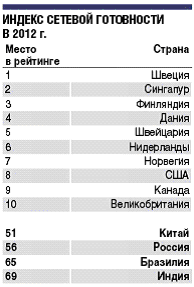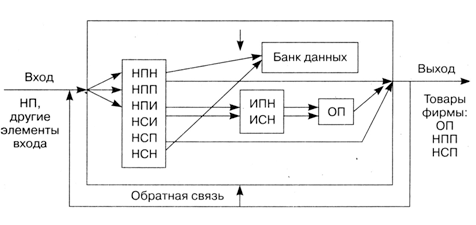Summary on the topic of final work
Contents
- Introduction
- 1. Relevance of the theme
- 2. The purpose and objectives of the research, the expected results
- 3. Overview of Research and Development
- 3.1 Overview of international sources
- 3.2 Overview of national sources
- 3.3 Overview of local sources
- 4. Innovation as an object of entrepreneurial innovation
- Conclusion
- source list
Introduction
Information Technology (IT) - a set of inter-related science, technology, engineering, studying the methods of efficient organization of people involved processing and storage of information using computer technology and methods of organization and interaction with people and production equipment, its applications, as well as related with all that social, economic and cultural problems. [8]
The current production of goods and other activities are increasingly in need of information services, processing huge amounts of information. Universal Technical processing means any information is a computer that acts as an amplifier intellectual capacities of man and society in general, and communication tools that use computers are used for communication and information transfer. The emergence and development of computers - is a necessary part of the process of information society.
1. Relevance of the topic
At the present period of transition with the variety of complex crisis economic processes and relationships between companies, financial institutions and states on the domestic and foreign markets acute problem is an effective investment (investment) capital in order to increase it. One promising area of ??investment is innovation. It is this branch is the most risky, but it provides the possibility of obtaining profits. One area of ??innovation has become the field of information technology.
Modern information technology with their rapidly growing potential and rapidly declining costs have great potential for new forms of work organization and employment in both individual corporations and society in general [9] . The spectrum of possibilities greatly expanded - innovations affect all spheres of human life, the family, education, work, the geographical boundaries of human communities, etc. Today, information technology can make a decisive contribution to strengthening the relationship between the growth of labor productivity, output, investment and employment . New services that extend across networks, is able to create a number of jobs, which is confirmed by the practice of recent years.
2. The purpose and objectives of the research, the expected results
The goal is to develop a master scientific and practical approaches to improve the efficiency of innovative projects and enterprises industry of Ukraine.
To achieve performance goals were set and solved a number of scientific challenges:
- nature and characteristics of innovation;
- legal aspects of the regulation of innovation;
- nature and characteristics of information technology, the innovation development;
- study innovation in the economy of Ukraine;
- analysis of the IT market in Ukraine;
- analysis of the enterprise in which to innovate;
- recommendations to enhance innovation in the Ukraine;
- recommendations to enhance innovation in the field of information technology;
- testing recommendations in practice.
object of study: the process of increasing the effectiveness of innovative projects.
subject of study: organizational and economic foundations of the process of improving the effectiveness of innovative projects in the field of information technology.
Methods: The study was conducted on the basis of classical economic theory and the theory of management of innovation processes. Classical instruments were used for analysis of statistical data, financial reporting, the synthesis of general conclusions, economic and mathematical methods, models describing the processes under study.
information basis of the work is the official publication of reports and analysis of the leading international economic organizations, Ukrainian and foreign statistical abstracts, laws, decrees of the President of Ukraine. [1]
3. Overview of Research and Development
The information technology industry is one of the fastest growing industries in the world. Over the last 5 years the industry revenues grew by an average of 10 percent per year, with an average growth rate of 3-4 per cent of the economy, which has led to an increase in the share of industry in GDP in both developed and developing countries. According to the forecasts of international analytical agencies, high growth rates of about 9 percent a year, will continue for the next five years.
3.1 Overview of international sources
Active use of the public companies and the Information Technology and Innovation leads to an increase in the competitiveness of national economies. The leaders in the use of information technology continue to be the industrialized countries, but the BRICS, despite some progress in this area, yet far behind them.
WEF experts prepared the Networked Readiness Index 2012 (Networked Readiness Index 2012) (Fig. 1), characterizing the development of information and communication technologies (ICT) in the world and its impact on competitiveness. The leaders of the index were Sweden, Singapore and Finland. Equally good results to these countries has been achieved through an enabling policy environment, effective legislation, developed infrastructure, active use of innovation and information technology companies, government agencies and the public, as well as a high level of education.
But the BRICS countries, though, shows the growing willingness of business and people to the use of ICT, yet far behind the industrial countries. Thus, China and Russia were only in the sixth top ten. Russia did not take the lead given the ineffectiveness of the legal system, excessive bureaucracy, and lack of implementation of ICT companies. Strengths of the country, according to the authors of the study include education of the population and the number of highly skilled workers, and a high level of mobile penetration.
The utilization of ICT is essential to assess the country's wealth. According to estimates consultancy Booz & Company, also participated in the study WEF, the increase in the use of ICT by 10% to GDP growth per capita by 0.6%, and a reduction in the unemployment rate to 0.8%. In this crucial role for ICT penetration in the life of companies and individuals play a supportive policy environment, legal environment and tax incentives. Their absence leads to a reduction of investment in ICT, which can have serious economic and social consequences. [3]

Figure 1 - The Networked Readiness Index in 2012
However, it is clear that a high level of access to information technologies - just one of many indicators affecting the well-being of a country. Most of the top ranking by countries with small and relatively stable economy, not currently experiencing problems such as debt and credit crisis, high unemployment. [4]
3.2 Overview of national sources
Information technology in recent years, growing rapidly in Ukraine. Today, the total annual amount of the market in the country is about 2 to 3 billion dollars. USA.
According to the World Economic Forum, has a positive effect on the development of information technologies in Ukraine
- high degree of involvement of the population in higher education;
- relative ease and speed of installation of commercial contracts;
- relative ease and speed of installation of commercial contracts;
- quality of mathematics education;
- satisfactory quality of the overall education system.
In Ukraine, there are about 23 thousand certified IT professionals, and this indicator is the fourth largest country in the world, after the United States (200 million), India (150 million) and Russia (70 million).
However, for the IT market in Ukraine is characterized by an imbalance in spending. Thus, the hardware is about 80% of the costs, while the services and the-shelf software - 10%, respectively. These figures show very high growth potential of the market, especially in the service and ready-made software. [5]
Problems of innovation activity takes a lot of national and international scientists. To justify the directions of innovative development of great theoretical and methodological importance are the works of scholars such as Geets VM, Goncharov NP, Butnik-Siverskiy AB Fedulova LI Seminozhenko VP Zavlin P . N. and others.
3.3 Overview of local sources
Innovative activities of IT companies remains poorly understood. So, not analyzed the processes of formation and improvement strategies to increase the effectiveness of innovative projects. In our time, in the Donetsk National Technical University, such issues are not addressed. And they are the impetus for further research.
4. Innovation as an object of entrepreneurial innovation
In modern conditions of high dynamism, instability and uncertainty of the functioning and development of enterprises and the environment, increasing competition and ever-decreasing product life cycles are becoming the most efficient system of innovation management companies to their inclusion on the most important aspects of their life. The main task of these systems, along with the survival is flexibility and adaptability of enterprises to develop and succeed in business.
scheme transformation innovations in innovation and the main product of the company is shown in Fig. 2.
meet social needs through continuous innovation helps to introduce new elements into the economy and industries, exceeding its technical and economic characteristics of the existing level. The creators of innovation on the one hand, improve the quality of life, and on the other, as a leader in technological development, forcing the others to move along, thus increasing the overall level of development of the economic environment as the individual city, region, country and the world at large .

Figure 2 - turning innovation into innovation
Legend:
- NP - innovations purchased;
- NNP - innovations purchased for accumulation;
- SPE - innovations purchased on sale;
- NPI - innovations purchased in innovation;
- NSI - innovations of its own design, implemented in innovation;
- NSP - innovations of its own design to sell;
- NSN - innovations of its own design for accumulation;
- PIT - innovations purchased innovations;
- ISN - Innovation own innovations;
- OP - the main products of the company.
Thus, the dual role of innovation as a means to meet the rising needs of society and the driving force of technological development, making them, on the one hand - the core of science and technology, on the other hand - one of the key components of entrepreneurial innovation.
When business organization subject innovatsiimogut act as a new or improved product, new or improved manufacturing process and organization. Under the terms of innovation in business deyatelnostiponimayutsya mechanisms entrepreneurial innovation as a system of education, principles of construction and management of the innovation sphere. [7]
The business organization of scientific and technical developments and innovations serve as an intermediate result of scientific-production cycle and to the extent practical applications become scientific and technological innovation. Scientific and technological developments and inventions are the application of the new knowledge to their practical use, as the scientific and technical innovation (STI) is the materialization of new ideas and knowledge, discoveries, inventions, and scientific and technological developments in the production process with a view to commercial sale to satisfy certain consumer demand. The indispensable qualities of innovation are scientific and technical novelty and industrial applicability. Commercial feasibility in relation to innovation appears as a potential property to achieve that requires some effort. STI describes the end result of scientific-production cycle (NPC), which acts as a specific product - scientific and technological products - and is the materialization of new ideas and knowledge, discoveries, inventions and developments in production for commercial implementation to meet specific needs. < /p>
Innovation result must be viewed in the context of entrepreneurial innovation. For innovation are of equal importance, all three properties: the scientific and technological innovation, manufacturing feasibility, commercial feasibility. [6]
Scientific and technological innovation must be new, to meet market demand and to bring profit to the manufacturer.
innovation lifecycle is shown in Fig. 3.

Figure 3 - The life cycle of innovation
Scientific, technological and innovation is essential to the development of innovative processes, and management of this area is one of the objectives of innovation manager.
Scientific and technical activities associated with the production, development, distribution and use of scientific and technical knowledge. It includes research and development, scientific and technical education and training, scientific and technical services.
Conclusions
Today, innovation is becoming a key factor in the development of most enterprises. Characteristic of an increasing number of scientific publications, which examines innovation. In most of them the emphasis is not on the price mechanism of competition and innovation in the processes related to the improvement of all of the economic potential of the company. That's why our scientists are trying to justify national innovation priorities, to find effective mechanisms for making and effective use of innovations. Thus, in our view, sufficiently elaborated our scientists question the economic evaluation of innovative processes, which could lead to the introduction of innovative production in advance of inefficient projects.
Source List
- The Law of Ukraine "On │nnovats│ynu d│yaln│st" / / V│domost│ Verhovno┐ sake (VVR), 2002, ╣ 36
- Fedorenko V. ▓nvestoznavstvo: P│druchnik. - 3-t║ look., Special stages. - K.: AIDP, 2004. - S. 470-472.
- PP Mikityuk ▓nnovats│yny management: Navchalny pos│bnik. - Ternopil: Ekonom│chna Dumka, 2006. - 295 p.
- about Zv│t sv│tovy rozvitok: vazhke zavdannya rozvitku Hardcover. s English. - K.: Abris, 1994.
- Innovation Management: Right, manual / Ed. PN Zavlina, AK Kazantsev, L. Mindeli. - 2nd ed., Rev. and add. - Moscow: CSRS, 1998.
- Innovation Management: Textbook. manual / Ed. LN Ogolevoy. - Moscow: INFRA, 2001.
- Innovation Management: Textbook / ed. SD Ilyenkov. - New York: Banks and Exchanges: UNITY, 1997
- Computational methods for implementing mental models of complex systems / NS Kovalenko, SA Samal. -Minsk: Belaruskaya Navuka. - 2004. - 166 p.
- Ueykerli D. Design of digital devices / D. Ueykerli. - Moscow: Postmarket, 2002. - Volume 2. - 528.
- Zavlin PN Vasiliev, A. Evaluation of innovation. - S.Pb.: Business Press, 1998.

